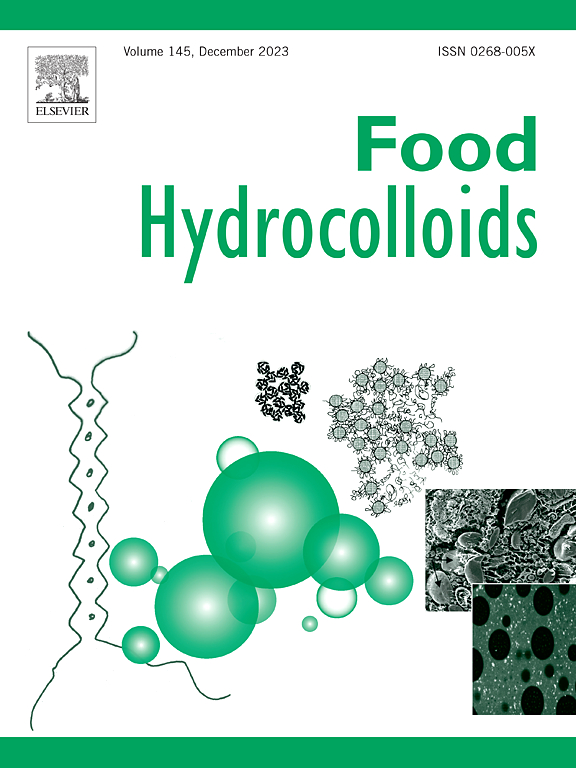IF 11
1区 农林科学
Q1 CHEMISTRY, APPLIED
引用次数: 0
摘要
多孔支架是应用于组织工程和细胞培养肉类生产的前景广阔的材料。然而,现有的研究一直在努力实现可食性、支架硬度和在这些支架上培养的干细胞行为之间令人满意的平衡。在本研究中,我们引入了双层凝胶,利用从大自然中提取的生物基材料(特别是豌豆蛋白和甲壳素)来创建可三维打印的多孔支架。通过在三维打印过程中喷洒 CaCl2 溶液,我们实现了支架前体结构的卓越保真度。由此产生的支架具有可调节的孔隙结构,能有效支持干细胞的粘附、增殖和分化等细胞行为。有趣的是,除了提高乳化能力外,添加甲壳素纳米晶体还能显著提高基于11S淀粉样纤维的支架的物理性质和生物学性能。这些三维打印支架作为理想的材料,为干细胞提供了先进的微环境,从而推动了组织工程和细胞培养肉类生产领域的发展。本文章由计算机程序翻译,如有差异,请以英文原文为准。

Food-grade 3D-Printable porous scaffolds with advanced stem cell microenvironments enabled by bilayer emulgel
Porous scaffolds represent promising materials for applications in tissue engineering and cell-cultured meat production. Nevertheless, existing efforts have struggled to achieve a satisfactory balance between edibility, scaffold stiffness, and the behavior of stem cells cultured on these scaffolds. In this study, we introduce bilayer emulgel as a mean of creating 3D-printable porous scaffolds using bio-based materials derived from nature, specifically pea protein and chitin. By incorporating the spray of CaCl2 solution during the 3D printing process, we achieve exceptional fidelity in the precursor architecture of the scaffolds. The resulting scaffolds, with adjustable pore structures, effectively support the cellular behaviors such as adhesion, proliferation, and differentiation of stem cells. Interestingly, apart from the advancement of emulsifying capability, the addition of chitin nanocrystals can significantly enhance the physical properties and biological performance of the scaffolds based on 11S amyloid fibrils. These 3D-printed scaffolds, serving as ideal materials, offer advanced microenvironments for stem cells, thereby advancing the fields of tissue engineering and cell-cultured meat production.
求助全文
通过发布文献求助,成功后即可免费获取论文全文。
去求助
来源期刊

Food Hydrocolloids
工程技术-食品科技
CiteScore
19.90
自引率
14.00%
发文量
871
审稿时长
37 days
期刊介绍:
Food Hydrocolloids publishes original and innovative research focused on the characterization, functional properties, and applications of hydrocolloid materials used in food products. These hydrocolloids, defined as polysaccharides and proteins of commercial importance, are added to control aspects such as texture, stability, rheology, and sensory properties. The research's primary emphasis should be on the hydrocolloids themselves, with thorough descriptions of their source, nature, and physicochemical characteristics. Manuscripts are expected to clearly outline specific aims and objectives, include a fundamental discussion of research findings at the molecular level, and address the significance of the results. Studies on hydrocolloids in complex formulations should concentrate on their overall properties and mechanisms of action, while simple formulation development studies may not be considered for publication.
The main areas of interest are:
-Chemical and physicochemical characterisation
Thermal properties including glass transitions and conformational changes-
Rheological properties including viscosity, viscoelastic properties and gelation behaviour-
The influence on organoleptic properties-
Interfacial properties including stabilisation of dispersions, emulsions and foams-
Film forming properties with application to edible films and active packaging-
Encapsulation and controlled release of active compounds-
The influence on health including their role as dietary fibre-
Manipulation of hydrocolloid structure and functionality through chemical, biochemical and physical processes-
New hydrocolloids and hydrocolloid sources of commercial potential.
The Journal also publishes Review articles that provide an overview of the latest developments in topics of specific interest to researchers in this field of activity.
 求助内容:
求助内容: 应助结果提醒方式:
应助结果提醒方式:


